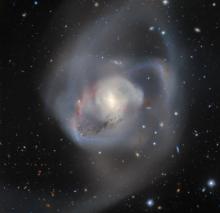Listen to today's episode of StarDate on the web the same day it airs in high-quality streaming audio without any extra ads or announcements. Choose a $8 one-month pass, or listen every day for a year for just $30.
You are here
NGC 7469
If we could speed up our view of the galaxy NGC 7469, it might look like halftime at the Super Bowl — flashes going off everywhere. In this case, the flashes represent the births of new stars. The galaxy contains more than a hundred star clusters that are no more than two million years old — mere newborns on the cosmic timescale. And each cluster contains hundreds to thousands of stars.
NGC 7469 is about 200 million light-years away. It’s in Pegasus, which is in the east at nightfall and climbs high across the sky later on.
The galaxy is a barred spiral — it has a “bar” of stars in its middle, with spiral arms curling off the ends of the bar. And it has a supermassive black hole in its heart. The black hole is encircled by a disk of superhot gas, which shines brightly.
The bar and spiral arms contain huge amounts of gas and dust — the raw materials for making stars. There’s also a huge ring of gas and dust around the black hole. Most of the new stars are being born in clusters in the ring, bar, and arms. Last year, James Webb Space Telescope found more than 60 young clusters, doubling the known population. Some of the clusters are just a million years old, and are still giving birth to stars.
Starbirth is driven in part by the black hole. Radiation and “winds” from the disk squeeze clouds of gas and dust. The clouds collapse to make more stars — flashes of starbirth in a busy galaxy.
Script by Damond Benningfield






